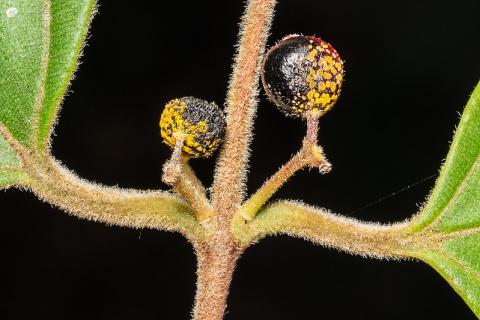Since its arrival in Australia in 2010, the exotic fungal disease myrtle rust has had a devastating impact on many of our native species in the Myrtaceae plant family.

In NSW, four species have been listed as critically endangered due to decline from myrtle rust, including once widespread and common species such as the scrub turpentine (Rhodamnia rubescens) and native guava (Rhodomyrtus psidioides).
Other species like the rose myrtle (Archirhodomyrtus beckleri), scaly myrtle (Gossia hillii) and silky myrtle (Decaspermum humile) are also badly affected in some parts of their range, leading to shifts in species composition in some rainforest communities.
NSW Biodiversity Conservation Trust regional conservation officer Sally Hawkins has been observing myrtle rust on plants while visiting landholders.
“Almost all our North Coast private land conservation properties with Wet Sclerophyll Forest have scrub turpentine trees struggling to survive from the pressure of the introduced pathogen” she said.
Scrub turpentine was once a very common understory species, yet, since the introduction of myrtle rust it has become so compromised it is now listed as critically endangered under State and Federal legislation.
“Unfortunately myrtle rust can no longer be contained in Australia’s eastern states” Sally said.
“However, with the help of citizen scientists and their smartphones, its influence can be monitored, and the data made available for ongoing research to track its impacts and find out if there is some resilience in threatened species populations.”
Threatened species project officer Craig Stehn reports that the NSW Saving our Species program is working to establish ex situ collections of these highly susceptible species and determine if some individuals are resistant to the rust. If successful, these resistant plants will then be used to reinforce wild populations against the impacts of myrtle rust.
“Conservation agreement-holders have committed to preserving their land for biological processes and there’s a real chance individual plants with genetic resistance to myrtle rust may be found on our conservation agreement properties,” Sally added.
How you can help
Citizen scientists play a crucial role in invasive species monitoring by reporting observations at a local level. The Atlas of Living Australia (ALA) is asking for help from interested nature lovers, and NSW Biodiversity Conservation Trust agreement-holders to combat the threat this invasive fungal pathogen poses to our high-risk species.
You can contribute to this research by recording your sightings on iNaturalist in the Myrtle Rust Citizen Science project.
“Projects such as the Myrtle Rust Project empower landholders to make an important contribution to conservation research and we encourage everyone to get involved,” Sally said.